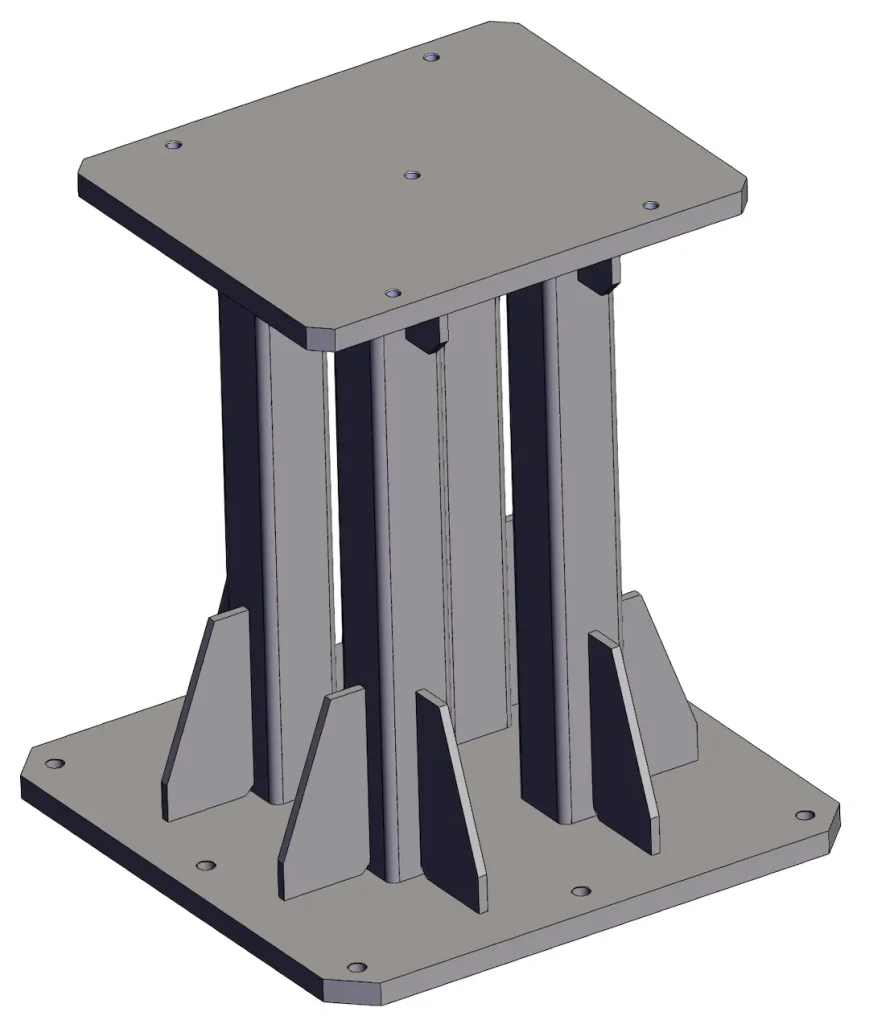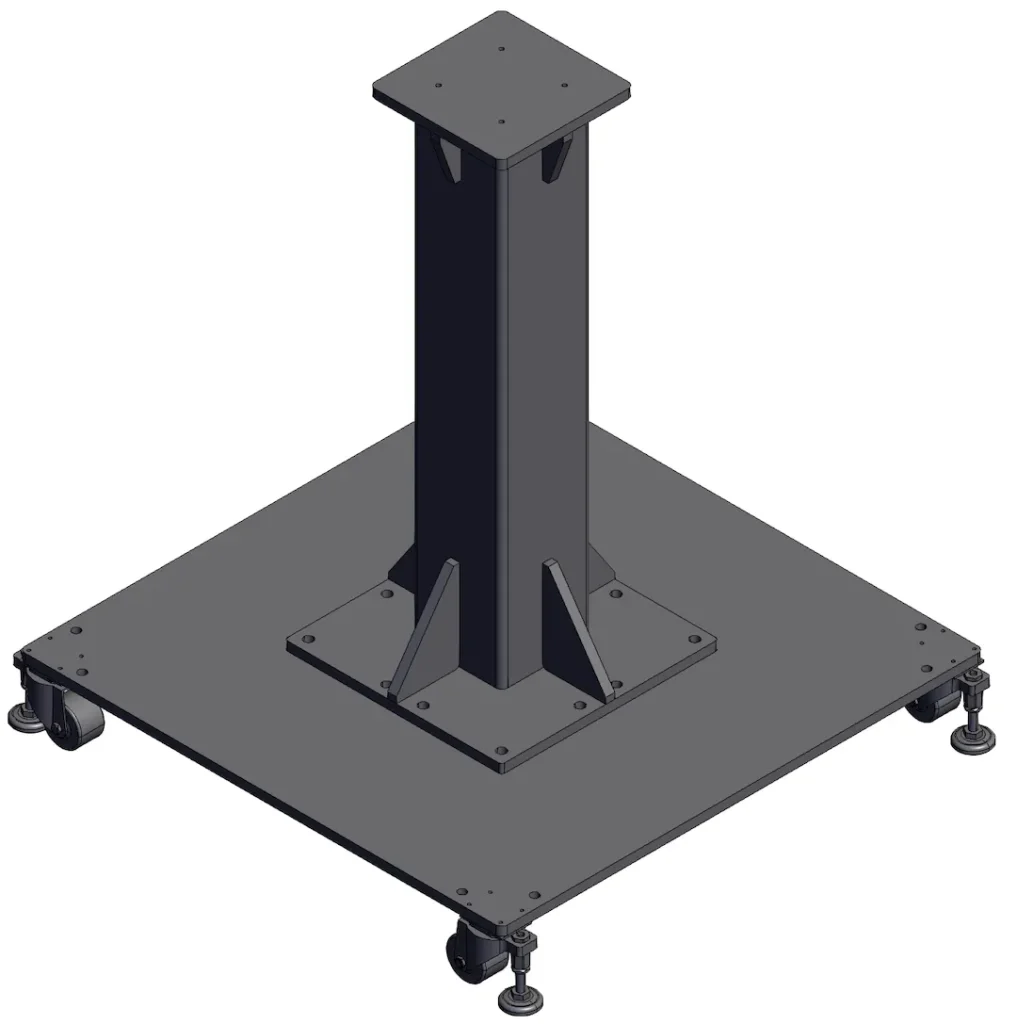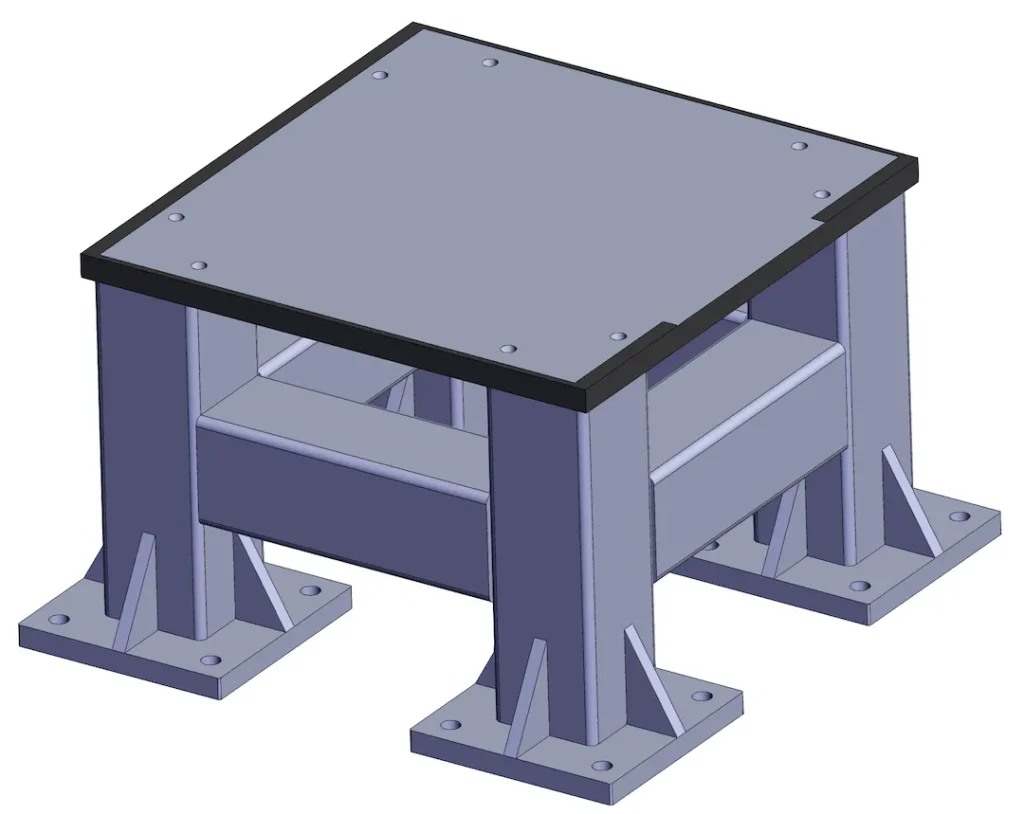Panoramica & Casi d'uso

Able Hardware designs and manufactures custom robot bases, alzate, pedestals, and welded cell frames that deliver stable, precise platforms for industrial robots, cobots, and automation peripherals. Built to metric specs with export-ready QA, our assemblies combine stiff welded structures with precision-machined datum pads and anchoring patterns to keep your robot exactly where your program expects it—shift after shift.
Sommario
Why this solution for robotics & automation environments
A robot’s accuracy is only as good as the structure beneath it. Our welded base and riser solutions increase stiffness, elevate reach, and improve line-of-sight while controlling vibration and thermal effects. Leveling pads (M20–M30) and precision shims enable quick installation; cable trays and pass-throughs simplify routing; datum pads allow CMM verification; and guarding/fencing interfaces speed cell integration. See related capabilities at montature in metallo personalizzate, saldatura automatica, e verniciatura a polvere.
Typical applications in robot cells (bases, alzate, cell frames)
- Robot bases and risers to set height/reach for handling, saldatura, palletizing, or inspection
- Cell frames with integrated cable management, utility rails, and guarding interfaces
- Pedestals with grout pockets, slotted anchor plates, and masked bonding points (ESD/ground)
- Utility skids for controllers, pneumatics, and power distribution beneath or beside the robot

Proprietà tecniche
Materiali, profili & loads; tolleranze (ISO 13920/ISO 2768) & qualità della saldatura (ISO 5817)
- Materiali & gradi: Q235/S235 and Q355/S355 for cost-effective stiffness; optional 304/316 stainless for hygiene/corrosion; optional 6061/6082 aluminum for weight-sensitive risers.
- Profili & spessori: RHS/SHS, piatto, channel; typical tube sizes 40da ×40×2 a 120×60×4 mm; base/top plates 10–30 mm; tasselli 6–10 mm.
- Dimensioni & loads: Tipico L×W×H 600×600×200 to 2000×1500×1000 mm with payloads sized to your robot and end-of-arm tooling. We match robot model footprints (mm) e anchor patterns (PCD/slots) to OEM specs.
- Tolleranze & geometry control: ISO 13920 classe A.C for welded constructions; ISO 2768 m/f generale. Guidance: pad flatness ≤0.5–1.0 mm, parallelism of pads ≤0.5–1.0 mm, squareness ≤1.0–1.5 mm/m. Weld symbols per ISO 2553.
- Qualità della saldatura: ISO 5817 classe B on visible/critical joints; classe C elsewhere. Structural reference AWS D1.1 available on request.
Finiture & protezione dalla corrosione (ISO 12944/ISO 8501)
- Preparazione della superficie: a ISO 8501.
- Rivestimenti: cappotto in polvere (tipico RAL, 70–100 µm), Zinco, E-coat, or industrial paint selected per environment using ISO 12944 categories.
- Electrical/ESD: masked grounds and bonding points provided where specified.
- Labels & sicurezza: asset labels, lift/center marks, and torque/anchor notes on request.
Opzioni di produzione
MIG automatico/robotico (e TIG se specificato), maschere & infissi, ripetibilità
We use MIG automatico/robotico for carbon steel frames and Tig where stainless/cosmetic seams are specified. Dedicated maschere & infissi ensure repeatable squareness and hole PCD location across pilot builds and series runs. WPS/PQR are available when needed.
Operazioni secondarie: taglio laser, piegarsi, lavorazione; cable management, rivestimento & confezione
- Taglio laser of base/top plates, PCDs, and slotted anchors; bending/forming for gussets and tray features.
- Lavorazione CNC of datum pads, bores, and interface faces for measured coplanarity.
- Integration details: cable trays, pass-through grommets, controller shelves, lifting eyes.
- Rivestimento via in-house/partner lines; confezione with protective wrap, bolt kits, shims, assembly notes, and crate/palletized shipments for export.
Tipi & Geometria
Common assemblies for robotics (basi robotiche, alzate, pedestals, cell frames, utility skids) & fasce di dimensionamento
- Robot bases: low-profile frames with heavy plates and leveling pads; tipico 600–1200 mm square footprints.
- Risers/pedestals: altezza 200–1000 mm with internal stiffeners; top pad machined and drilled per robot model.
- Cell frames: modular sub-bases for multi-robot cells, with guarding and service interfaces.
- Utility skids: RHS/plate structures supporting valves, power, and cooling on a mobile or fixed frame. Sizing is driven by robot footprint, dynamic loads, and anchoring strategy (PCD, slot ranges, grout pockets). Provide your target vibration/stiffness or allowable tip/tilt—our engineering support will size sections accordingly.

Qualità & Test
Ciò che verifichiamo (VT, DFT, CMM checks; PT/MT/RT opzionale) e documentazione (WPS/PQR, CoC)
- Ispezione visiva (VT 100%) of all welds; ISO 2808 DFT checks on coating thickness.
- CMM verification of PCDs, datum pads, and pad coplanarity/parallelism; documented levelness checks.
- CND opzionale: PT/MT/RT for critical joints per your plan.
- Docs delivered: WPS/PQR (se applicabile), CoC, material certs, and inspection reports.
Prezzi & Tempi di consegna
Moq, sample/pilot builds, Driver di costo indicativi (Nessun prezzo duro)
- Moq: flexible for prototypes/pilots; economical series start at low dozens depending on size.
- Tempi di consegna: prototypes typically 2–4 weeks after drawing sign-off; produzione 4–7 weeks depending on coating queue and machining content.
- Cost drivers: plate thickness and grade, machining of datum pads/bores, sistema di rivestimento (powder vs e-coat), tolerance class (ISO 13920 B vs C), NDT scope, and packaging/export kit. Provide drawings with target flatness/parallelism and robot model/PCD to refine the quote.
Standard & Conformità
Standard/certificazioni pertinenti & Documentazione fornita
We build to ISO 13920, ISO 2768, e ISO 2553 symboling, with weld acceptance to ISO 5817 (classe B/C). Coatings are selected and verified to ISO 12944 with prep to ISO 8501. On request, projects can reference AWS D1.1 for structural guidance and incorporate WPS/PQR and welder qualifications accordingly.

FAQ
Q1. Which materials do you recommend?
Carbon steels Q235/S235 o Q355/S355 offer the best stiffness-to-price. Scegliere 304/316 stainless for hygiene/corrosion exposure, o 6061/6082 aluminum for weight-sensitive risers.
Q2. What stiffness/levelness targets are typical?
Common guidance is pad flatness ≤0.5–1.0 mm e parallelism ≤0.5–1.0 mm across mounting pads, with overall squareness ≤1.0–1.5 mm/m. We’ll size sections to meet your deflection limits.
Q3. How tight can you hold PCD and datum tolerances?
Laser-cut holes and CNC-machined datum pads routinely achieve ±0.1–0.2 mm location on PCDs depending on size; we verify with CMM and provide reports.
Q4. What weld class do you use?
isible/critical joints to ISO 5817 classe B, general frame joints to classe C, unless your spec requires otherwise.
Q5. Which coatings and masked grounds can you provide?
Cappotto in polvere (typ. 70–100 µm), Zinco, E-coat, or paint. We mask grounding/ESD points per drawing and can add labels for bonding.
Q6. What are the MOQ and lead time?
Prototypes welcome; series MOQ depends on size and coating. Typical lead times: 2–4 weeks (prototipo), 4–7 weeks (series).
D7. What drawings do you need for quoting?
Provide L×W×H, robot footprint and PCD, target tolerances (flatness/parallelism), sistema di rivestimento, and NDT/QA documents required.
Upload drawing / Get a quote
Ready to size your base or riser? Upload your drawing (STEP/DWG/PDF) with robot model, PCD, and tolerance targets. Our engineering team will propose a cost-effective, testable design and issue a fast custom service quotation.